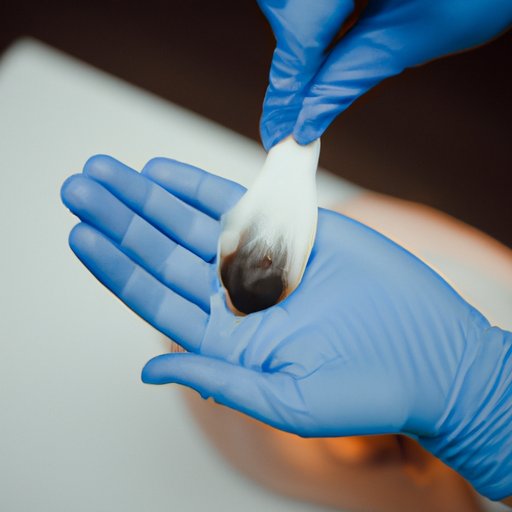Introduction
An infected hair follicle is a common skin condition that can cause redness, itching, pain, and pus-filled bumps on the affected area. It’s important to know how to treat an infected hair follicle in order to reduce the symptoms and prevent further infection. There are a variety of treatments available, including home remedies, antibiotic ointments, oral antibiotics, cleaning the area, and hot compresses.
Home Remedies
One of the most popular home remedies for treating an infected hair follicle is a mixture of honey, olive oil, and tea tree oil. This combination has natural antibacterial properties that can help reduce inflammation and fight off infection. To use this remedy, mix equal amounts of honey, olive oil, and tea tree oil together, then apply it directly to the affected area. Leave it on for up to 20 minutes, then rinse off with water. Repeat this process twice a day for best results.
The benefits of using home remedies for an infected hair follicle include being able to access them without a prescription, being relatively low cost, and having fewer side effects than medications. However, if your symptoms do not improve after two weeks of using home remedies, you should seek medical advice from your doctor.
Antibiotic Ointments
Antibiotic ointments are another option for treating an infected hair follicle. These ointments work by killing bacteria and reducing inflammation. They come in a variety of forms, such as creams, gels, lotions, and sprays. Your doctor may prescribe a specific type of antibiotic ointment depending on the type of infection you have.
When applying antibiotic ointment, make sure to clean the affected area first with soap and water. Then, apply a thin layer of the ointment to the area, making sure to cover all of the affected skin. Allow the ointment to dry before covering it with a bandage or gauze pad. You should apply the ointment several times a day until the infection has cleared.
Oral Antibiotics
In some cases, your doctor may prescribe oral antibiotics to treat an infected hair follicle. This is usually done if the infection is severe or does not respond to other treatments. Oral antibiotics work by killing the bacteria that are causing the infection. Common types of oral antibiotics include amoxicillin, ciprofloxacin, and doxycycline.
It’s important to take oral antibiotics exactly as prescribed by your doctor. If you don’t take them as directed, the infection may not be fully treated. Additionally, oral antibiotics can cause side effects such as nausea, vomiting, and diarrhea. If you experience any of these side effects, contact your doctor immediately.
Cleaning the Area
Keeping the affected area clean is an important part of treating an infected hair follicle. Start by washing the area with an antibacterial soap. Make sure to use a gentle cleanser and lukewarm water. Pat the area dry with a clean towel, then apply a thin layer of antibiotic ointment or cream. Do not use any products that contain alcohol, fragrances, or dyes, as these can irritate the skin.
Hot Compresses
Applying hot compresses to the affected area can help reduce inflammation and speed up the healing process. To use this method, soak a clean cloth in warm water, then wring out the excess liquid. Place the cloth over the infected area for 10 to 15 minutes at a time. Repeat this process several times a day for best results.
The benefits of using hot compresses include relieving pain, reducing inflammation, and helping the body to heal faster. However, it’s important to be careful when using hot compresses, as they can burn the skin if left on for too long.
Conclusion
An infected hair follicle can cause redness, itching, pain, and pus-filled bumps on the affected area. Treating an infected hair follicle requires a combination of home remedies, antibiotic ointments, oral antibiotics, cleaning the area, and hot compresses. Each of these treatments has its own benefits and potential side effects, so it’s important to speak to your doctor before starting any new treatment.
It’s also important to practice good hygiene and keep the affected area clean. Doing so will help reduce the risk of infection and promote faster healing. With proper treatment, an infected hair follicle can be cleared up quickly and effectively.


